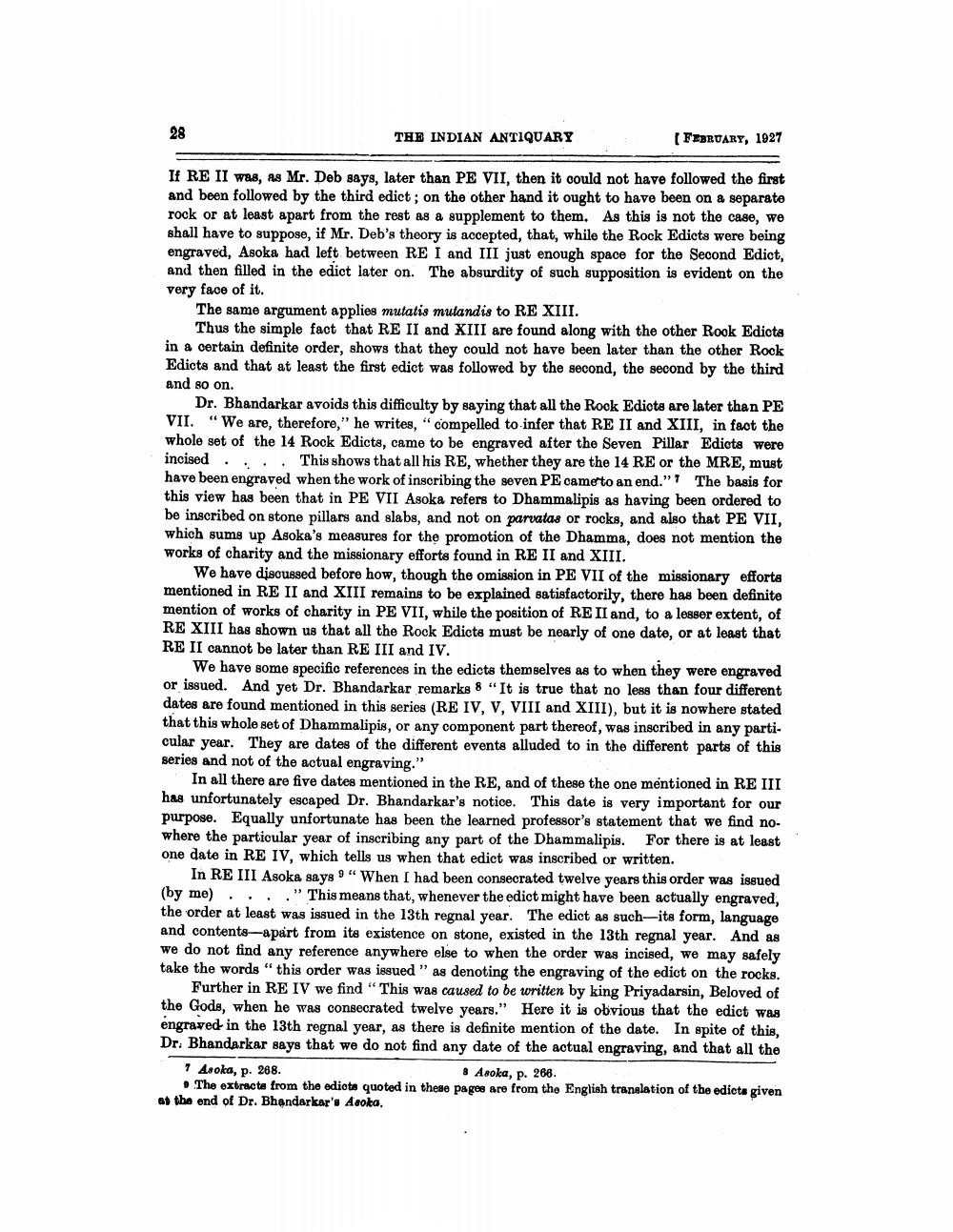________________
28
THE INDIAN ANTIQUARY
(FEBRUARY, 1927
If RE II Was, As Mr. Deb says, later than PE VII, then it could not have followed the first and been followed by the third edict; on the other hand it ought to have been on a separate rock or at least apart from the rest as a supplement to them. As this is not the case, we shall have to suppose, if Mr. Deb's theory is accepted, that, while the Rock Edicts were being engraved, Asoka had left between RE I and III just enough space for the Second Edict, and then filled in the edict later on. The absurdity of such supposition is evident on the very face of it.
The same argument applies mutatis mutandis to RE XIII.
Thus the simple fact that RE II and XIII are found along with the other Rook Edicta in a certain definite order, shows that they could not have been later than the other Rock Edicts and that at least the first edict was followed by the second, the second by the third and so on.
Dr. Bhandarkar avoids this difficulty by saying that all the Rock Ediota are later than PE VII. "We are, therefore," he writes, compelled to infer that RE II and XIII, in fact the whole set of the 14 Rock Edicts, came to be engraved after the Seven Pillar Edicts were incised ... This shows that all his RE, whether they are the 14 RE or the MRE, must have been engraved when the work of inscribing the seven PE came to an end."" The basis for this view has been that in PE VII Asoka refers to Dhammalipis as having been ordered to be inscribed on stone pillars and slabs, and not on parvatas or rocks, and also that PE VII, which sums up Asoka's measures for the promotion of the Dhamma, does not mention the works of charity and the missionary efforts found in RE II and XIII.
We have discussed before how, though the omission in PE VII of the missionary efforts mentioned in RE II and XIII remains to be explained satisfactorily, there has been definite mention of works of charity in PE VII, while the position of RE II and, to a lesser extent, of RE XIII has shown us that all the Rock Edicts must be nearly of one date, or at least that RE II cannot be later than RE III and IV.
We have some specific references in the edicts themselves as to when they were engraved or issued. And yet Dr. Bhandarkar remarks 8 "It is true that no less than four different dates are found mentioned in this series (RE IV, V, VIII and XIII), but it is nowhere stated that this whole set of Dhammalipis, or any component part thereof, was inscribed in any parti. cular year. They are dates of the different events alluded to in the different parts of this series and not of the actual engraving."
In all there are five dates mentioned in the RE, and of these the one mentioned in RE III has unfortunately escaped Dr. Bhandarkar's notice. This date is very important for our purpose. Equally unfortunate has been the learned professor's statement that we find nowhere the particular year of inscribing any part of the Dhammalipis. For there is at least one date in RE IV, which tells us when that edict was inscribed or written.
In RE III Asoka says 9 "When I had been consecrated twelve years this order was issued (by me) ..." This means that, whenever the edict might have been actually engraved, the order at least was issued in the 13th regnal year. The edict as such-its form, language and contents-apart from its existence on stone, existed in the 13th regnal year. And as we do not find any reference anywhere else to when the order was incised, we may safely take the words "this order was issued " as denoting the engraving of the edict on the rocks.
Further in RE IV we find "This was caused to be written by king Priyadarsin, Beloved of the Gods, when he was consecrated twelve years." Here it is obvious that the edict was engraved in the 13th regnal year, as there is definite mention of the date. In spite of this, Dr. Bhandarkar says that we do not find any date of the actual engraving, and that all the Asoka, p. 268.
Asoka, p. 268. The extracts from the edita quoted in these pages are from the English translation of the edicta given at the end of Dr. Bhandarkar's Asoka,




